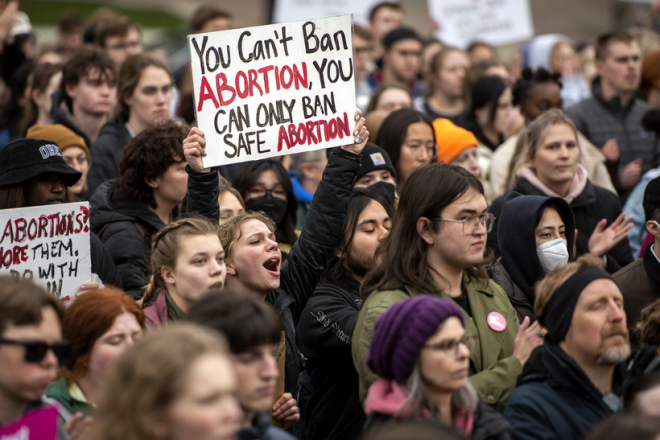The precedent that first enabled abortion to become legal nation-wide in the USA is set to be overturned, according to a leaked draft obtained by the news website Politico. The draft majority opinion report showed that the Supreme Court was in favour of overturning their landmark 1973 ruling. This would result in an immediate ban on abortion in over 10 states where trigger laws are in place. More than 20 states in total are likely to impose bans. The ruling is set to be overturned in late June/early July.
Ordinary people reacted with fury and took to the streets across the country in protest the following day. There has also been a large outcry online, with a multidue of polls over recent years consistently showing that the overwhelming majority of people support abortion being legal, and oppose overturning Roe v. Wade.
The Supreme Court and Roe v. Wade
The precedent, known as Roe v. Wade, was the result of a Supreme Court ruling in 1973. In 1969, a young woman living in Texas, Norma McCorvey, who used the pseudonym “Jane Roe,” became pregnant with her third child. McCorvey wanted to have an abortion, which was illegal in Texas unless it was necessary to save the mother’s life. McCorvey filed a lawsuit arguing that the abortion ban was unconstitutional and faced prosecutor Henry Wade. Eventually her case made it all the way to the Supreme Court, where a 7-2 majority ruled that states do not have the power to ban abortion and that a woman’s right to terminate her pregnancy is protected by the U.S. Constitution.
The Supreme Court is the highest authority on and ‘interpreter’ of the US Constitution. At the time, it was determined that women and people who can get pregnant have “an unstated but implied right in the Constitution to privacy and bodily autonomy.” (NB: Trans men and non-binary people who have internal reproductive organs can also become pregnant – read more here)
This ruling effectively legalised abortion nation-wide as Supreme Court rulings take priority over any conflicting state laws. If the ruling is overturned, then abortion rights will be at the discretion of each state.
Roe v. Wade has faced numerous challenges since the ruling was handed down, however all have been unsuccessful thus far. The current challenge comes from the state of Mississippi and with the Supreme Court now made up of a majority of conservative appointees, it could be successful.
Under the Trump regime, three conservative anti-abortion justices were appointed including Brett Kavanaugh – who faced mass opposition to his appointment – and Amy Coney Barrett who has been extremely vocal on her personal views against abortion. (NB: in the US, the judges of the Supreme Court are known as justices.)
This has shifted the balance on the Supreme Court which was already an out of touch institution that wields too much power in the US, the so-called “land of the free”.
The failure of the Democrats to enshrine abortion rights in federal law
The Democratic Party, despite campaigning on ‘codifying’ Roe v. Wade during both presidential campaigns for Obama and Biden, has refused to take meaningful action. For decades, the Democrats have exploited fears about Roe v. Wade being overturned to urge people to vote for them. However, once in power, no steps have been taken to enshrine abortion rights in federal law.
This week, the Women’s Health Protection Act failed to pass the Senate, as expected, with all Republican Senators and one Democratic Senator voting it down 51-49. For a bill to proceed to the final vote in the Senate, a ‘super majority’ of 60 votes is required to end the debate, i.e. votes from both Republicans and Democrats.
This is where the tradition of ‘filibusters’ comes in, where debate is drawn out indefinitely thus delaying the bill progressing to the final vote. The mere threat of filibusters means that many bills don’t even start being debated.
However, the so-called filibuster rule can be overturned such as in 2013 when the Democrats removed the threshold regarding most nominees for administration jobs, and again in 2017 from the Republicans regarding Supreme Court nominees.
The Democrats under Obama actually held a super majority for a brief time when first elected which would not have required even changing the filibuster rule. However, it is clear that while an effective rallying call, abortion rights are not a priority for Democrats when in power.
If the filibuster rule was overturned, the Democrats would be able to pass the law with Kamala Harris holding the tie-breaking vote. However, Biden refused to change the rule regarding the Women’s Health Protection Act under the guise of protecting US democracy and checks and balances.
Again, this is typical of the Democrats who have shown time and again that they are not real friends of working class people. It is also another example of the peculiarities of US ‘democracy’ that are not replicated in other advanced capitalist countries.
The Democrats’ hand wringing and cynical calls ahead of the midterm elections to just elect more pro-choice senators are part of the reason that things are playing out as they are. Ordinary people are sick of empty rhetoric from career politicians who only wish to protect their corporate backers and uphold this undemocratic system.
Abortion rights are a class issue
“You can’t ban abortion, only safe abortion,” is a quote that has been shared online and on protest signs in the wake of the leaked report. If people don’t want to be pregnant, as we have seen throughout history, they will try anything to end their pregnancy resulting in dangerous ‘backyard abortions.’ All working class people should demand that we do not go backwards.
Socialists believe that a hallmark of a fair and just society is valuing the right of women and those who can get pregnant to choose if, how and when they have children. In fact, the first place in the world to legalise abortion was the Soviet Union after the 1917 revolution. The ruling class of the US would have been at home in Tsarist Russia it seems!
Abortion bans do not affect everyone equally – they will disproportionately affect working class and poor people. While wealthy women will have the means to travel for abortions, or pay for it to happen (more or less) safely behind closed doors, this is not something that working class people have the luxury of.
Forcing people to be pregnant and give birth will only further deepen the record inequality that exists. At the same time, for those who want to have children, the necessary support is totally lacking. The claimed “interest” of the so-called “pro-life” campaigns is completely hypocritical in that sense.
The right to childcare, healthcare and welfare payments to support those who choose to have children needs to be part of the broader struggle for reproductive rights. The US lags behind many advanced capitalist countries in this regard, with woeful to non-existent support in place – or unattainable for ordinary people.

Control over our bodies
At the same time, all over the world, women face varying levels of sexism and oppression – without any exception. Reproductive rights are not the only area where capitalism seeks to control women’s bodies; billion-dollar industries are dedicated to dictating how we look, whether it be clothing, beauty or weight loss – it is never-ending!
Of course, it is not just about how we look either. In order to function, capitalism relies on the unpaid domestic labour of women. Studies have estimated that the work women do in the home saves capitalism trillions of dollars a year!
Restricting abortion rights is just one of the ways that the system seeks to prevent the emancipation of working class women. The gains that have been made for women in the last couple of hundred years have all been hard fought for and resisted every step of the way by a system that is reliant upon keeping us divided.
Those in power will stop at nothing to keep the status quo. In order to maintain this status quo, it is in the interests of the system to keep the majority of the world – the working class and poor – divided. For this reason, socialists say that working class women, LGBT+ people, and people of colour are doubly oppressed; first on the basis of our class and then on the basis of our gender, sexual identity or race.
The broader impacts of banning abortion & fighting back
The leaked Supreme Court report was a draft, and is not expected to be finalised until late June/early July. In this time, the justices could change their opinions, and the vote could go a different way. If it does go the way that is indicated in the draft report, it will set a worrying precedent for the overturning of other rights determined to be Constitutional such as those around marriage equality.
The Roe v. Wade ruling came at a time of historic societal upheaval, on the back of working class struggle following a leftward shift around the world, and in the US in particular following the civil rights and anti-Vietnam war movements.
It is not only possible through active mass opposition to enact change, but it is in fact the only way change can happen. This is why it’s crucial that working class people of all genders and races come together to fight against the reactionary agenda of the right. Students, community organisations, labour unions and working class people more broadly banding together is necessary to beat back these attacks.
If Roe v. Wade is overturned, it will effectively give a green light to attack women’s rights more broadly. Successfully banning abortions will unleash the reactionary forces to wind back reforms and begin attacks in other arenas. The impact of this will be felt globally due to the dominant role of the US.
The majority of the US population support abortion and reproductive rights. This support and the initial fury to the leaked report must be harnessed into meaningful and sustained action. By getting organised, and decisively breaking with the Democrats, working class people can begin to take on the undemocratic nature of the US political system. The fight to defend Roe v. Wade is just the beginning, reproductive rights must be enshrined at a federal level. This includes the struggle for Medicare For All and the right to free, quality public healthcare at all stages of life.
Although, obviously, women face different challenges in each country, in general some of the demands of the women’s movement should include, but not be limited to:
- Free and accessible medical and surgical abortion on demand, fully covered by the public health system, available in all hospitals and accessible beyond just major cities
- Comprehensive, evidence-based sex education beginning in primary education
- Fully free and available contraception and sexual health services including access to IVF from the public health service
Beyond the above demands, which are primarily around the prevention of unwanted pregnancies and access to abortion services, the movement should also demand that working class people have a genuine choice about whether to have children by demanding real support for people who want to become parents:
- Long maternity and parental leaves
- Shorter work weeks with no loss of pay
- Efficient and free of charge childcare
- A sufficiently funded and functioning public school system
- Free education from early childhood to university.
For a woman to truly choose, the economic burdens of parenthood need to be removed. Real choice requires women to have full equality in the workplace:
- For the union movement to genuinely take up the fight for women’s liberation
- Fight for equal pay for equal work, parental leave and decent welfare payments for all
- The burden to fund all of the above should be on the shoulders of capitalists, who squeeze profit out of everything and have accumulated unimaginable wealth
An all-out fight to prevent Roe v. Wade being overturned will need to be waged, let alone the struggle for abortion rights and reproductive rights more broadly. This will not be an easy task. The overturning of this precedent is just the latest example of how reforms won under capitalism are temporary. Any gains that can be made can also be wound back in the future when the establishment feels it is safe to do so.
This is why the fight for reproductive rights is also the fight for a different way of organising society. Our rights should not be subject to the whims of a ruling elite. In contrast to capitalist society, a socialist society would be built on the basis of working class unity. It is on this basis that humanity will be able to move forwards to true equality and liberation for all.



